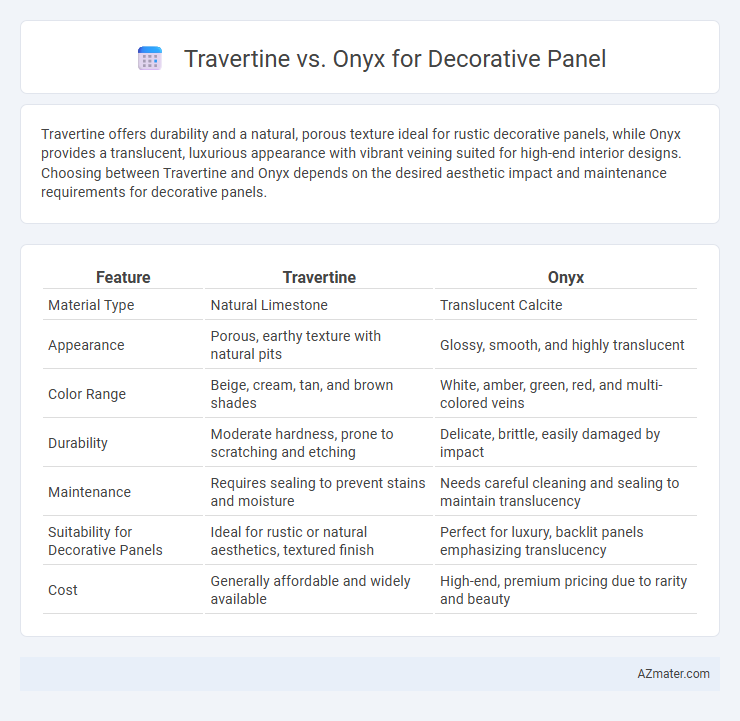Travertine offers durability and a natural, porous texture ideal for rustic decorative panels, while Onyx provides a translucent, luxurious appearance with vibrant veining suited for high-end interior designs. Choosing between Travertine and Onyx depends on the desired aesthetic impact and maintenance requirements for decorative panels.
Table of Comparison
| Feature | Travertine | Onyx |
|---|---|---|
| Material Type | Natural Limestone | Translucent Calcite |
| Appearance | Porous, earthy texture with natural pits | Glossy, smooth, and highly translucent |
| Color Range | Beige, cream, tan, and brown shades | White, amber, green, red, and multi-colored veins |
| Durability | Moderate hardness, prone to scratching and etching | Delicate, brittle, easily damaged by impact |
| Maintenance | Requires sealing to prevent stains and moisture | Needs careful cleaning and sealing to maintain translucency |
| Suitability for Decorative Panels | Ideal for rustic or natural aesthetics, textured finish | Perfect for luxury, backlit panels emphasizing translucency |
| Cost | Generally affordable and widely available | High-end, premium pricing due to rarity and beauty |
Introduction to Travertine and Onyx Decorative Panels
Travertine decorative panels showcase a natural, porous limestone with rich earth tones and unique veining, ideal for adding warmth and texture to interior spaces. Onyx decorative panels feature a translucent, crystalline stone prized for its luxurious appearance and vibrant color variations, often illuminated to enhance its natural glow. Both materials offer distinct aesthetic qualities, making them popular choices for sophisticated wall cladding and accent features.
Visual Appeal: Travertine vs Onyx Aesthetics
Travertine offers a natural, earthy appearance with warm beige tones and distinct porous textures that create a rustic and timeless look for decorative panels. Onyx provides a luxurious, translucent surface with vibrant color variations and intricate veining that enhance visual depth and elegance. For visual appeal, onyx panels stand out with their rich, glowing translucency, while travertine delivers a classic, matte finish favored in traditional designs.
Color and Pattern Variations
Travertine offers warm, earthy tones with natural pore patterns and linear veining, creating a rustic, textured aesthetic ideal for decorative panels. Onyx displays vibrant, translucent colors ranging from deep reds to milky whites, featuring dramatic swirling and banded patterns that enhance backlit panel designs. The color and pattern variations in Travertine emphasize subtle elegance and durability, while Onyx delivers bold, luminous visual impact suited for high-end, artistic interiors.
Durability and Strength Comparison
Travertine offers excellent durability for decorative panels due to its dense, porous structure that resists cracking under impact and weathering. Onyx, while visually striking with its translucent properties, is softer and more prone to scratching and chipping, making it less suitable for high-traffic or outdoor applications. When comparing strength, travertine's higher compressive strength and resistance to abrasion make it a more reliable choice for long-lasting decorative surfaces.
Applications in Interior Design
Travertine offers a warm, natural texture ideal for rustic or Mediterranean-inspired interiors, commonly used in wall cladding, fireplace surrounds, and backsplashes to create earthy, elegant focal points. Onyx panels provide a translucent, polished surface that enhances modern luxury spaces with dramatic backlit installations, making it perfect for feature walls, bars, and reception desks. Both materials serve distinct aesthetic roles in interior design, with travertine emphasizing durability and organic appeal, and onyx highlighting opulence and intricate veining.
Maintenance and Cleaning Requirements
Travertine requires regular sealing and gentle cleaning with pH-neutral cleaners to prevent staining and etching, making maintenance moderately demanding. Onyx is more delicate and porous, necessitating meticulous care with specialized, non-abrasive products to avoid surface damage and discoloration. Both natural stones benefit from prompt spill cleanup and avoidance of harsh chemicals for long-lasting decorative panel aesthetics.
Installation Complexity and Techniques
Travertine installation for decorative panels requires skilled handling due to its porous nature, necessitating sealing before and after placement to prevent staining and ensure durability, typically involving adhesive mortar and mechanical fixing. Onyx panels demand precise cutting and backlighting considerations because of their translucency and fragility, with installation often incorporating specialized support frames and epoxy adhesives to maintain structural integrity and aesthetic appeal. Both materials require professional expertise, but Onyx's complexity in handling and illumination integration generally results in a more challenging installation process than Travertine.
Cost Differences: Travertine vs Onyx Panels
Travertine panels generally cost between $15 and $30 per square foot, offering a more affordable option for decorative wall applications compared to onyx panels, which typically range from $40 to $100 per square foot due to their rarity and translucency. Installation costs for onyx can also be higher because of the material's fragility and the need for specialized backing and lighting to enhance its natural glow. The price difference reflects not only the material expense but also the complexity of fabrication and installation, making travertine a cost-effective choice for budget-conscious projects.
Environmental Impact and Sustainability
Travertine, a natural limestone, offers better sustainability due to its abundance and lower processing emissions compared to onyx, which is a rarer form of calcite requiring more energy-intensive extraction and polishing. Travertine's porous nature allows for easier recycling and repurposing, reducing landfill waste, whereas onyx's fragility often leads to higher breakage rates and material loss. Choosing travertine for decorative panels supports environmental responsibility by minimizing carbon footprint and promoting resource efficiency.
Choosing the Right Stone for Your Space
Travertine offers a natural, earthy aesthetic with its porous texture and warm tones, making it ideal for creating a timeless, rustic look in decorative panels. Onyx features a translucent quality with vibrant, swirling patterns that backlight beautifully, perfect for adding luxury and drama to interiors. Selecting between travertine and onyx depends on desired durability, lighting conditions, and overall design goals for the space.

Infographic: Travertine vs Onyx for Decorative Panel
 azmater.com
azmater.com